

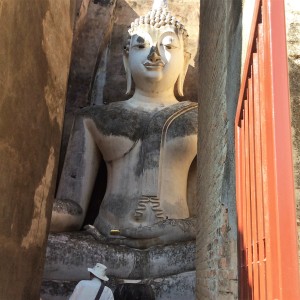 The serenity of temples in Thailand, their sense of happiness! Buddha is the focus, like the cross in a church. He may be bronze and shining, green glass or
The serenity of temples in Thailand, their sense of happiness! Buddha is the focus, like the cross in a church. He may be bronze and shining, green glass or 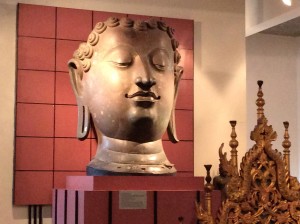 jade, or brick covered with stucco, or painted gold. He’s duplicated many times, and surrounded by male followers. He’s curiously androgynous. If you look at him with his rounded visage and body, his swelling
jade, or brick covered with stucco, or painted gold. He’s duplicated many times, and surrounded by male followers. He’s curiously androgynous. If you look at him with his rounded visage and body, his swelling  breasts and slim waist, his hair in a topknot, you can imagine him as a capable headmistress, firm but kind, sympathetic but very much in charge. (There’s something androgynous about all charismatic figures, whether film stars, saints or gods – they appeal to men and women). His ears are long and often pierced, because he comes from an aristocratic family, and in his early life wore earrings. Or, these ears are huge because he hears everything. His fingers are long and tapering – and at a open temple in Sokutai the nails are painted with gold leaf. Squares of gold leaf are often applied by devotees to Buddha statues, making them bristly if it peels off.
breasts and slim waist, his hair in a topknot, you can imagine him as a capable headmistress, firm but kind, sympathetic but very much in charge. (There’s something androgynous about all charismatic figures, whether film stars, saints or gods – they appeal to men and women). His ears are long and often pierced, because he comes from an aristocratic family, and in his early life wore earrings. Or, these ears are huge because he hears everything. His fingers are long and tapering – and at a open temple in Sokutai the nails are painted with gold leaf. Squares of gold leaf are often applied by devotees to Buddha statues, making them bristly if it peels off.
He’s sacred, and you don’t want to lark around one of his statues in the park, taking a pic of your pal’s grinning head popping up behind an ancient headless Buddha, or you’ll be flung out.
The Buddha’s sitting – lotus position naturally – or lying before his joyful reception into nirvana. (I was reminded of those Greek paintings of the Dormition of the Virgin, reclining at her death and ascension into heaven). Or he stands facing us, his right thumb touching forefinger, in teaching mode. Or his palm faces us – quieten down you noisy lot. This might be the ocean raging, or us quarrelling. Silent language speaking over centuries.
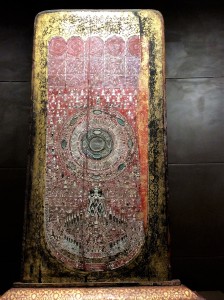 His footstep. Huge, patterned and bejewelled. Where he has been, his presence. I think of my friend Vennessa’s Reiki, and how in her therapy she concentrates on the foot as the seat – or stamp – of being.
His footstep. Huge, patterned and bejewelled. Where he has been, his presence. I think of my friend Vennessa’s Reiki, and how in her therapy she concentrates on the foot as the seat – or stamp – of being.
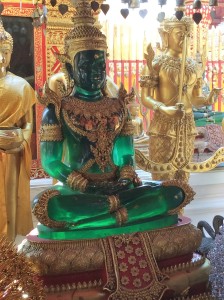 And the green Buddhas – do they now have an environmental aspect? There are green monks, saving the forests. Only the king or his son may touch the emerald Buddha in Bangkok which is jade. Two translucent Buddhas sit at the Soi
And the green Buddhas – do they now have an environmental aspect? There are green monks, saving the forests. Only the king or his son may touch the emerald Buddha in Bangkok which is jade. Two translucent Buddhas sit at the Soi  Dukoi temple on the mountain outside Chiang Mai, pure green glass.
Dukoi temple on the mountain outside Chiang Mai, pure green glass.
Also in temples is the fat Buddha, who in fact (I was sorry about this) is not the Buddha Gautama but a merry monk named Buddai now often conflated with the Buddha and associated with, what else, happiness and riches. No worries about his weight! He’s joyful – he accepts life’s natural pleasures.
 In the Wat Umong on the outskirts of Chiang Mai there’s a ghastly black emaciated Buddha, his veins like worms on a corpse. This is the Buddha in his early days, trying out fasting as the path to enlightenment. It wasn’t, and as he
In the Wat Umong on the outskirts of Chiang Mai there’s a ghastly black emaciated Buddha, his veins like worms on a corpse. This is the Buddha in his early days, trying out fasting as the path to enlightenment. It wasn’t, and as he 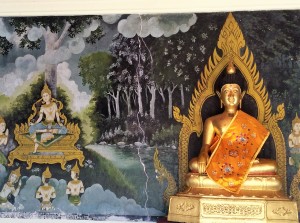 carried on meditating he arrived one day, under a bodhi tree in a park running with deer, at the four noble truths, of which I think the main ones state that suffering is caused by desire, and meditation is the best way to expunge desire and realise the unreality of the desired. Neither extreme ascetism nor hedonism is the path to joyful peace. I’m not a Buddhist, I can’t help being more an animist – finding the spirit in everything and everywhere, particularly nature, it’s just there – but of the official religions, I find Buddhism superior to others. I learn from it, and there’s one Buddha head at Ayutthaya cradled in the roots of a Bodhi tree where art, nature and religion are at one. It says everything.
carried on meditating he arrived one day, under a bodhi tree in a park running with deer, at the four noble truths, of which I think the main ones state that suffering is caused by desire, and meditation is the best way to expunge desire and realise the unreality of the desired. Neither extreme ascetism nor hedonism is the path to joyful peace. I’m not a Buddhist, I can’t help being more an animist – finding the spirit in everything and everywhere, particularly nature, it’s just there – but of the official religions, I find Buddhism superior to others. I learn from it, and there’s one Buddha head at Ayutthaya cradled in the roots of a Bodhi tree where art, nature and religion are at one. It says everything.
Copyright Sarah Coles 2018 Privacy Policy Website Design & Creation Forum Media and Design - Alresford